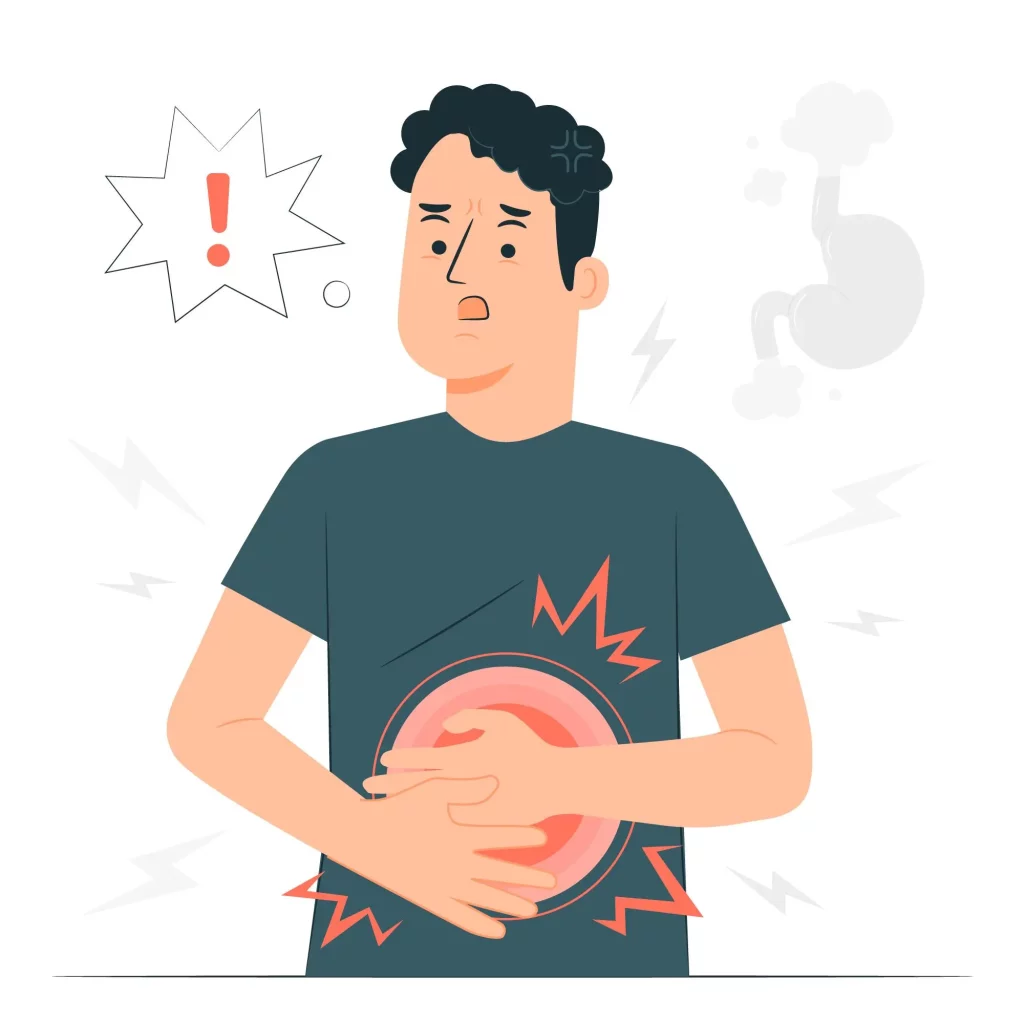What is Epigastric pain?
Epigastric pain is characterized by a burning, gnawing, or sharp pain in the upper abdomen. Patients often describe it as a feeling of discomfort or pressure in the epigastric region. Understanding the nature of this pain is essential for accurate diagnosis and treatment. Moreover, Here, we will take you on a journey to understand this pain better.Causes of Epigastric Pain
Understanding the causes behind epigastric pain is the first step in effectively managing it. Furthermore, There are numerous conditions and factors that can lead to this discomfort, including:- Gastroesophageal Reflux Disease (GERD): One of the leading causes of epigastric pain is GERD, where stomach acid flows back into the esophagus, causing irritation and discomfort.
- Peptic Ulcers: Ulcers in the stomach or duodenum can result in epigastric pain. These sores are often caused by the bacterium H. pylori or excessive use of non-steroidal anti-inflammatory drugs (NSAIDs).
- Gallstones: Gallstones can block the bile duct, leading to intense epigastric pain, often accompanied by nausea and vomiting.
- Pancreatitis: Inflammation of the pancreas can cause severe epigastric pain, typically radiating to the back.
- Indigestion: Simple indigestion or overeating can result in mild epigastric discomfort, usually after meals.
- Heart Issues: Sometimes, heart burning problems can cause pain that is perceived as epigastric in nature.
Understanding Epigastric Pain: Decoding the ICD-10 Code
Epigastric pain, also known as upper abdominal pain, is a symptom rather than a diagnosis in itself. To gain a comprehensive understanding, let’s break it down using the ICD-10 code, which is a standardized system for classifying diseases and health conditions.The ICD-10 Code for Epigastric Pain
Under the ICD-10 code, epigastric pain falls under category R10, which is specifically reserved for abdominal and pelvic pain. More specifically, it is coded as R10.13. Additionally, This code helps healthcare professionals accurately document and communicate the nature of the pain, facilitating effective diagnosis and treatment.Diagnosis Through ICD-10 Codes
In the world of healthcare, accurate diagnosis is crucial for effective treatment. ICD-10 codes play a pivotal role in coding and classifying diseases and conditions. Moreover, Here, we will explore some common ICD-10 codes associated with epigastric pain:- R10.13: This code is used for epigastric pain without any specific cause.
- K25.0: This code represents gastric ulcer.
- K21.9: It corresponds to gastroesophageal reflux disease without esophagitis.
- K85.9: This code stands for acute pancreatitis without specified complications.
- K80.80: It represents the presence of multiple gallstones without obstruction.
Importance of Accurate Coding
Accurate coding of epigastric pain is vital for proper patient care and efficient healthcare operations. It also ensures that patients receive appropriate treatment and that healthcare providers are reimbursed correctly for their services.Symptoms Associated with Epigastric Pain
When decoding epigastric pain, it’s essential to consider associated symptoms, which can provide valuable diagnostic clues. Moreover, Common symptoms include:- Nausea and vomiting
- Heartburn or acid reflux
- Loss of appetite
- Bloating
- Belching
- Blood in vomit or stool (a potential sign of gastrointestinal bleeding.
Diagnosing Epigastric Pain
Diagnosing the underlying cause of epigastric pain requires a thorough evaluation by a healthcare professional. Diagnostic methods may include:- Physical Examination: The doctor will perform a physical exam and inquire about your medical history.
- Endoscopy: A flexible tube with a camera (endoscope) is used to visualize the upper digestive tract, allowing for the detection of ulcers, inflammation, or other abnormalities.
- Imaging: X-rays, CT scans, or ultrasound may be recommended to assess the gallbladder, pancreas, or other organs.
- Laboratory Tests: Blood tests can reveal markers of inflammation, infection, or pancreatic dysfunction.
Treatment Options
Treatment for epigastric pain depends on the underlying cause. Options may include:- Over-the-counter or prescription medications can help manage conditions like GERD or peptic ulcers.
- Dietary changes, weight management, and avoiding trigger foods can alleviate symptoms.
- In severe cases, surgery may be necessary to remove gallstones or repair damaged organs.
- Treating conditions such as pancreatitis or gallbladder disease is essential for long-term relief.
Final thoughts
In the world of medical coding, precision is essential. Epigastric pain, a common symptom, requires accurate coding to ensure proper diagnosis and treatment. By understanding the ICD-10 codes associated with epigastric pain and the underlying causes, healthcare providers can navigate the coding landscape effectively.Why choose Zee Medical Billing?
Unlock the future of medical billing excellence with Zee Medical Billing! Our expert team handles complex billing operations and documentation with unparalleled precision. Trust us to optimize your healthcare practice’s financial health while ensuring top-notch patient care. Join hands with Zee Medical Billing today for a healthier, more prosperous tomorrow.Frequently Asked Questions
Mild epigastric pain may respond to lifestyle changes such as dietary modifications, stress reduction, and avoiding trigger foods.
Sudden and severe epigastric pain should prompt an immediate visit to the emergency room, as it could indicate a serious medical condition.
While epigastric pain can be a symptom of a heart attack, it is often accompanied by other symptoms like chest pain, shortness of breath, and sweating. If you suspect a heart attack, seek immediate medical attention.
Heart-related chest pain often radiates to the left arm, neck, or jaw, while epigastric pain is localized in the upper abdomen.
Epigastric pain can mimic the symptoms of heart-related issues, but it is more commonly associated with gastrointestinal problems. However, it’s essential to rule out heart problems if you experience severe or persistent epigastric pain.





